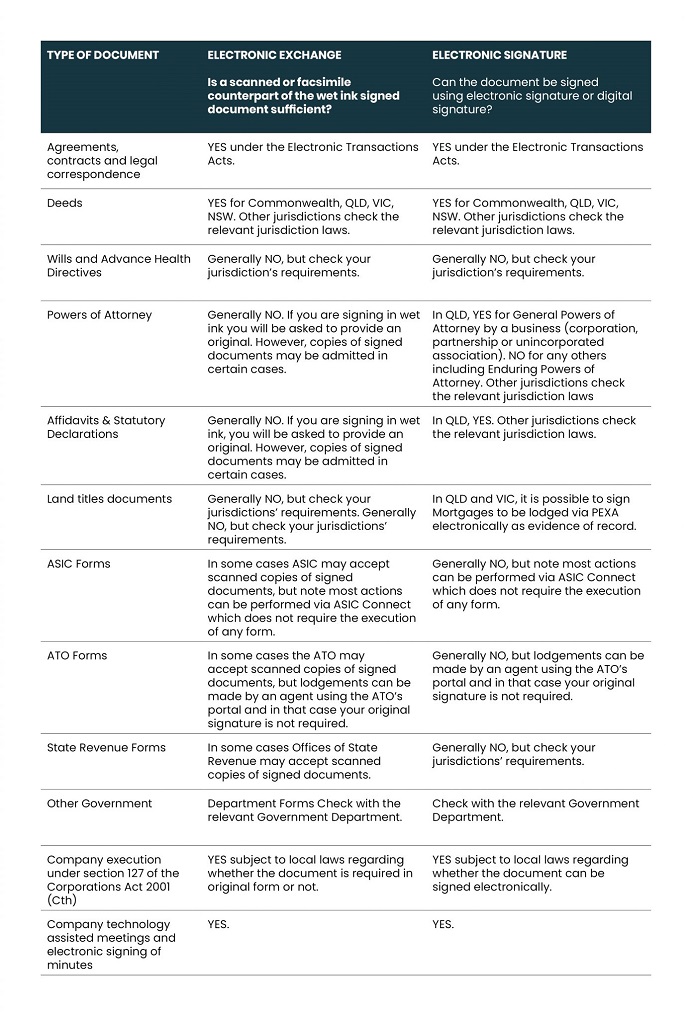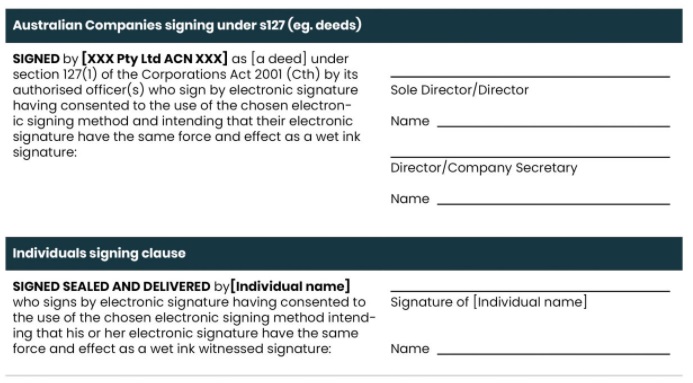Some time ago, we released our article Signing Electronically Explained, which considered signing electronically during the pandemic and the efforts that each State and Territory in Australia was making to permit the execution of important documents electronically. This was, of course, to avoid the need for physical meetings with witnesses, finding scanning facilities, postage and handling.
Significant steps forward have been made since then, and it is now time to provide an update outlining what the position is now, which will likely be the situation for some time going forward.
The key takeaways are:
- There is a difference between exchanging a document that has been signed in wet ink electronically (for example by fax or email) and signing using an electronic signature or digital signature.
- Although most documents can now be signed electronically there remain certain documents that cannot.
- Different jurisdictions have different requirements for signing electronically so you must check what your jurisdiction allows and any pre-requisites required.
- If you are signing an important document with electronic signature, it is recommended that you use a reliable method with safety features that makes it likely, on the balance of probabilities, that it was the person intended to have signed the document who signed.
The journey to electronic execution
Years ago, the Electronic Transactions Acts were passed by each State and Territory that authorised legal relations to be formed electronically. This is why your solicitor probably told you to be careful what you write in an email! And why for some time, parties have been signing and exchanging contracts by facsimile or email. We will refer to this as 'electronic exchange'.
A lot has happened since then, so where are we now? And importantly, where are we at with signing by 'electronic signature'?Many have interpreted the Electronic Transactions Acts also to permit the signing of documents by electronic signature or digital signature. An electronic signature is the affixing a mark to a document electronically that represents that persons' signature or intention to be bound, which may or may not be coupled with a digital certificate connecting the mark to the signer's identity. You will be familiar with electronic signatures if you have used DocuSign, Adobe Sign, or other similar platforms.
Unfortunately, there were always questions as to the use of electronic exchange and electronic signature for certain legal relations, and, as at last year, there was certainly a number of documents which legislation either expressly or impliedly required to be signed in wet ink, witnessed, and in original form. This includes contracts labelled as 'deeds', wills and other testamentary documents, powers of attorney, statutory declarations, affidavits, land title documents, and government forms, which were each the subject of varying degrees of laws regarding execution and admissibility.
That position has changed substantially as a result of the Covid-19 pandemic, which forced the legislature to give the nagging issue of how documents can be signed lawfully electronically its deserved attention. As of today, a number of jurisdictions, including the Commonwealth, Queensland, Victoria and NSW, have introduced permanent laws to permit the execution of most documents remotely via electronic signature and electronic exchange. Unfortunately, there remain some exceptions.
What documents can be signed electronically?

We are often asked what classification 'loan documents' fall into. Loan documents are usually a package of documents containing a mixture of agreements, deeds, declarations and land titles documents (the mortgage). In most cases, the majority of these documents can be signed by electronic exchange or with electronic signature, at least in QLD, VIC and NSW. However, the lender may not be satisfied with this.
It is important to remember that electronic execution is simply one method of execution that can be legally recognised in certain cases. The parties to legal relations must agree on what execution method they wish to adopt; in fact, it is a requirement that each party must consent to using electronic means.
Consequently, there are situations where a party, such as a lender, will insist on a wet ink signature or on receiving an original signed document before proceeding, even if, by law, a scanned copy might have been sufficient.
What is an acceptable electronic signature?
If you are able or offered to sign a document using an electronic signature, then you need to consider what method of electronic signature will be acceptable because electronic signature ranges from signing your name at the bottom of an email to utilising a recognised digital signing platform.
In some cases, it is actually possible that an electronic execution can be more reliable than an old wet ink witnessed signature. Remember that, until recently, the checking of identity of signers and witnesses was almost unheard of.
The type of method you choose will depend on the importance of the document at hand, but before making your choice, you need to consider:
- The requirements of the other party - as outlined above, the other party to your transaction may have specific requirements for what they will accept; and
- The requirements of the relevant law - in Queensland, to execute a document such as a deed, affidavit, or declaration, you must use an 'accepted method'.
The Queensland 'accepted method' for electronically signing a document is defined as a method that:
- identifies the signer for the document and the signer's intention in relation to the contents of the document; and
- is either -
-
- as reliable as appropriate for the purposes for which the document is made or signed, having regard to all the circumstances, including any relevant agreement; or
- proven in fact to have fulfilled the functions described in paragraph (a), by itself or together with further evidence; and
- is consented to by each other signer to the document.
'consent' is defined to include 'consent that can reasonably be inferred from the conduct of the person concerned, but does not include consent given subject to conditions unless the conditions are complied with.'
This definition reflects the accepted basic requirements of enforceability of electronic documents, which are:
- (consent) consent to the use of technology (as required by the Electronic Transactions Act); and
- (evidentiary reliability) use of a technology that shows that, on the balance of probabilities, it was the person who was supposed to have signed who signed, and not any other person, unless it was with the authority of the person who was supposed to have signed.
Recommended procedure for signing electronically
We recommend you do the following if you wish to have a document signed electronically in a manner that is safe and compliant, including with the Queensland 'accepted method':
- (confirm consent) Agree in writing in advance (e.g. by email) on the choice of method for electronic signing with the other signers or their legal representatives.
- (use a safe platform) Use an electronic signing platform that provides for safety mechanisms such as PIN code (examples include DocuSign and Citrix RightSignature). Do not accept electronic signatures affixed by a party using their own unverified software or a system that is unverifiable by you (This includes Adobe Acrobat as, unfortunately, anyone can set up an Adobe profile under any name. We would accept the use of Adobe Acrobat signature for a legal document only in connection with additional evidence of signing identity).
- (use personal emails only) Only send email invitations to sign to the signer's personal email address. Do not use group emails, general enquiry emails, or the spouse's email address, which invite questions of who had access to the email account.
- (communicate PIN securely) Communicate the PIN number by text message to the signer's personal mobile number. Consider communicating a PIN by phone call if you need to, for example, if you have no option but to send an invitation to a less than desirable email address.
- (write down what you did) Document the procedure that you used with a file note.
We recommend that your document contains an appropriate execution clause that makes provision for electronic signing. For example, we recommend:
Execution clause - full text for agreements and contracts:
(a) This [Agreement] may be executed in any number of counterparts, including by exchange of signed counterparts by hand depvery, post, email or facsimile, or a combination thereof. All counterparts taken together shall comprise this [Agreement].
(b) This [Agreement], or any individual counterpart, may also be executed by the use of electronic or digital signature, which the parties agree shall have the same force and effect as a wet ink witnessed signature. /p>
(c) To the extent that the parties execute this [Agreement] by an electronic execution method, they each agree that they have provided their consent to the use of the relevant execution method and may not subsequently challenge the vapdity of this [Agreement] on the grounds of consent or the effectiveness of the chosen execution method.
(d) Depvery of a copy of this [Agreement] or any other document contemplated by it, bearing an original or electronic signature, by facsimile transmission, by email in portable document format (.pdf) form, or by any other electronic means intended to preserve the original appearance of a document, shall have the same effect as physical depvery of the paper document bearing an original or electronic signature.
(e) To the extent that any person signs this [Agreement] as representative of a party, that person warrants to each other party that he or she is duly authorised to enter into this [Agreement] on behalf of the party he or she represents and his or her execution will bind that party under its constituent documents and jurisdiction, and the jurisdiction of this [Agreement].
(f) If there is any defect in the execution of this [Agreement] or if reasonably requested by any party, each party undertakes to ratify its execution of this [Agreement] and or execute a second copy of this [Agreement] or any document pursuant to it that is required in wet ink form, including for the purpose of registration or submission of documents required in original form. Such execution shall be deemed a ratification and relate back to that party's original execution of this [Agreement].
Execution clause - essential version for small documents
This [Document] may be executed in any number of counterparts (including counterparts exchanged by email or facsimile) and or by digital or electronic signature. All counterparts taken together shall comprise this [Document]. Where the parties sign this [Document] by electronic means, the parties agree that they have each consented to the agreed method of execution and may not subsequently challenge the validity of this [Document] on the grounds of consent or effectiveness of the chosen method of execution.
Your Document should have appropriate execution blocks that have been prefilled to avoid unnecessary aspects such as unnecessary witness boxes.
We recommend execution boxes as follows:

The content of this article is intended to provide a general guide to the subject matter. Specialist advice should be sought about your specific circumstances.

